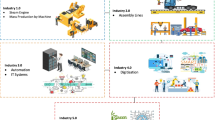Abstract
A manufacturing system is composed of and operated by many components; motors, cylinders, and sensors. Its purpose is to increase operational performance without system error or jam. And, recently, the Green IT/S (information technologies and systems) refer to processes that directly or indirectly address environmental sustainability in organizations. Green IT addresses energy consumption, reduces the bad productivity, and increases system operational efficiency using the computer. However, when the system experiences some problem or operational error, users (system operators or managers) often find it difficult to locate the jam position immediately and precisely. It is also difficult to know the cause of the jam and to manage jam information even after they read and find relevant error text in a repair manual for the system. This research proposes a method to efficiently manage jam status for manufacturing systems. For this purpose, a topic map was used. The topic model has topic types, associations, and occurrences, which relate to operational jam, system jam, and system components. All jam status information to support users is managed by XML specification, distinctly and efficiently.








Similar content being viewed by others
References
Andreas CP, John HLV, Alexander HS (1998) Heat-transfer enhancing features for handler tray-type device carriers. IEEE Trans Compon Packaging Manuf Technol, Part C 21(4):302–310
Ari I, Muhtaroglu N (2013) Design and implementation of a cloud computing service for finite element analysis. Adv Eng Softw 60–61:122–135
Beier JR, Tesche T (2001) Navigation and interaction in medical knowledge spaces using topic maps. Int Congr Ser 1230:384–388
Bi ZM, Wang L (2010) Advances in 3D data acquisition and processing for industrial applications. Robot Comput-Integr Manuf 26(5):403–413
Bose R, Luo X (2011) Integrative framework for assessing firms’ potential to undertake Green IT initiatives via virtualization—a theoretical perspective. J Strateg Inf Syst 20:38–54
Butler T (2011) Compliance with institutional imperatives on environmental sustainability: building theory on the role of Green IS. J Strateg Inf Syst 20:6–26
Cai S et al (2013) Exploring the role of IT for environmental sustain ability in China: an empirical analysis. Int J Prod Econ. doi:10.1016/j.ijpe.2013.01.030
Chou DC, Chou AY (2012) Awareness of Green IT and its value model. Comput Stand Interfaces 34:447–451
Cochran DS, Arinez JF, Duda JW, Linck J (2001/2002) A decomposition approach for manufacturing system design. J Manuf Syst 20(6):371–389
Advantest Introduces New M6241 Dynamic Test Handler, http://www.advantest.de/dasat/index.php?cid=100282&conid=101193&sid=2ec9c6bdf8ea55c6a24e5b13124acab1
Gonzalo M, Nicholas GO (2005) An approach using Petri Nets and improved heuristic search for manufacturing system scheduling. J Manuf Syst 24(2):79–92
Hasse N, Andersson PH (2010) Simulation of service-oriented and distributed manufacturing systems. Robot Comput-Integr Manuf 26:622–628
Hunter SL (2001/2002) Ergonomic evaluation of manufacturing system designs. J Manuf Syst 20(6):429–444
ISO/IEC 13250 (2002) Topic maps, information technology document description and processing languages
Jenkin TA, Webster J, McShane L (2011) An agenda for ‘Green’ information technology and systems research. Inf Organ 21:17–40
Jeong HY (2006) The component based factory automation control in the Internet environment. Lecture notes in computer science, vol 4270. Springer, Berlin
Karabeg D, Guescini R, Nordeng TW (2005) Flexible and exploratory learning by polyscopic topic maps. In: Proceedings of the fifth IEEE international conference on advanced learning technologies
Kim Y, Chang H (2012) IT convergence index and measurement design in the manufacturing industry. J Converg 3(3):47–50
Kim B, Youn C-H, Park Y-S, Lee Y, Choi W (2012) An adaptive workflow scheduling scheme based on an estimated data processing rate for next generation sequencing in cloud computing. J Inf Process Syst. doi:10.3745/JIPS.2012.8.4.555
Kusunoki K, Imai I, Negi T, Matsuda N, Ushijima K (2002) A proposal and evaluation of a method of remote access to FA controllers via the Internet. Electron Commun Jpn 82(6):23–32
Liu DR, Ke CK, Lee JY, Lee CF (2008) Knowledge maps for composite e-services: a mining-based system platform coupling with recommendations. Expert Syst Appl 34:700–716
Murugesan S (2008) Harnessing Green IT: principles and practices. IT Professional 10(1):24–33
Newman D, Baldwin T, Cavedon L, Huang E, Karimi S, Martinez D, Scholer F, Zobel J (2010) Visualizing search results and document collections using topic maps. J Web Semant 8:169–175
Pan Y, Zhang J (2012) Parallel programming on cloud computing platforms—challenges and solutions. J Converg 3(4):23–28
Pearn WL, Chung SH, Chena AY, Yang MH (2004) A case study on the multistage IC final testing scheduling problem with reentry. Int J Prod Econ 88:257–267
Semiconductor Test Equipment on http://www.siliconfareast.com/testeqpt.htm
Silas S, Ezra K, Blessing Rajsingh E (2012) A novel fault tolerant service selection framework for pervasive computing. Hum-Cent Comput Inf Sci. doi:10.1186/2192-1962-2-5
Vrabič R, Butala P (2011) Computational mechanics approach to managing complexity in manufacturing systems. CIRP Ann Manuf Technol 60:503–506
Williams RA, Benhabib B, Smith KC (1996) A DES-theory-based hybrid supervisory control system for manufacturing systems. J Manuf Syst 15(2):71–83
Xu X (2012) From cloud computing to cloud manufacturing. Robot Comput-Integr Manuf 28(1):75–86
Acknowledgements
This research supported by the MSIP (Ministry of Science, ICT and Future Planning), Korea, under the ITRC (Information Technology Research Center) support program (NIPA-2013-H0301-13-4007) supervised by the NIPA (National IT Industry Promotion Agency)
Author information
Authors and Affiliations
Corresponding author
Rights and permissions
About this article
Cite this article
Park, J.H., Jeong, H.Y. Cloud computing-based jam management for a manufacturing system in a Green IT environment. J Supercomput 69, 1054–1067 (2014). https://doi.org/10.1007/s11227-013-1007-7
Published:
Issue Date:
DOI: https://doi.org/10.1007/s11227-013-1007-7




